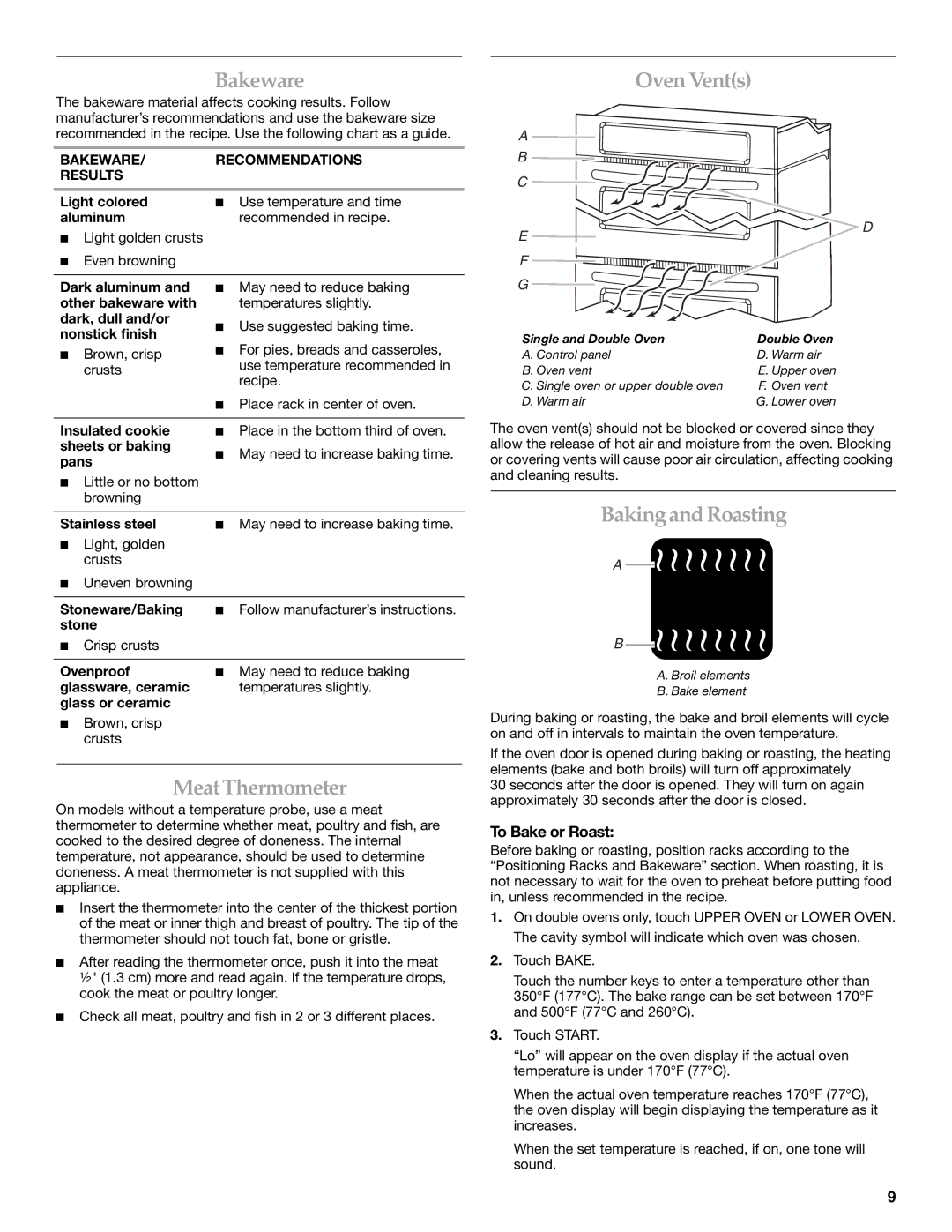
Bakeware
The bakeware material affects cooking results. Follow manufacturer’s recommendations and use the bakeware size recommended in the recipe. Use the following chart as a guide.
BAKEWARE/ | RECOMMENDATIONS |
RESULTS |
|
|
|
Light colored | ■ Use temperature and time |
aluminum | recommended in recipe. |
■Light golden crusts
■Even browning
Dark aluminum and | ■ | May need to reduce baking | |
other bakeware with |
| temperatures slightly. | |
dark, dull and/or | ■ | Use suggested baking time. | |
nonstick finish | |||
■ For pies, breads and casseroles, | |||
■ Brown, crisp | |||
| use temperature recommended in | ||
crusts |
| ||
| recipe. | ||
|
| ||
| ■ Place rack in center of oven. | ||
|
|
| |
Insulated cookie | ■ | Place in the bottom third of oven. | |
sheets or baking | ■ | May need to increase baking time. | |
pans | |||
|
| ||
■Little or no bottom browning
Stainless steel | ■ May need to increase baking time. |
■Light, golden crusts
■Uneven browning
Stoneware/Baking | ■ Follow manufacturer’s instructions. | |
stone |
| |
■ | Crisp crusts |
|
|
| |
Ovenproof | ■ May need to reduce baking | |
glassware, ceramic | temperatures slightly. | |
glass or ceramic |
| |
■ | Brown, crisp |
|
| crusts |
|
MeatThermometer
On models without a temperature probe, use a meat thermometer to determine whether meat, poultry and fish, are cooked to the desired degree of doneness. The internal temperature, not appearance, should be used to determine doneness. A meat thermometer is not supplied with this appliance.
■Insert the thermometer into the center of the thickest portion of the meat or inner thigh and breast of poultry. The tip of the thermometer should not touch fat, bone or gristle.
■After reading the thermometer once, push it into the meat ½" (1.3 cm) more and read again. If the temperature drops, cook the meat or poultry longer.
■Check all meat, poultry and fish in 2 or 3 different places.
OvenVent(s)
A ![]()
B ![]()
C ![]()
E | D |
| |
F |
|
G |
|
Single and Double Oven | Double Oven |
A. Control panel | D. Warm air |
B. Oven vent | E. Upper oven |
C. Single oven or upper double oven | F. Oven vent |
D. Warm air | G. Lower oven |
The oven vent(s) should not be blocked or covered since they allow the release of hot air and moisture from the oven. Blocking or covering vents will cause poor air circulation, affecting cooking and cleaning results.
BakingandRoasting
A ![]()
![]()
![]()
![]()
![]()
![]()
![]()
![]()
![]()
B ![]()
A. Broil elements
B. Bake element
During baking or roasting, the bake and broil elements will cycle on and off in intervals to maintain the oven temperature.
If the oven door is opened during baking or roasting, the heating elements (bake and both broils) will turn off approximately
30 seconds after the door is opened. They will turn on again approximately 30 seconds after the door is closed.
To Bake or Roast:
Before baking or roasting, position racks according to the “Positioning Racks and Bakeware” section. When roasting, it is not necessary to wait for the oven to preheat before putting food in, unless recommended in the recipe.
1.On double ovens only, touch UPPER OVEN or LOWER OVEN. The cavity symbol will indicate which oven was chosen.
2.Touch BAKE.
Touch the number keys to enter a temperature other than 350°F (177°C). The bake range can be set between 170°F and 500°F (77°C and 260°C).
3.Touch START.
“Lo” will appear on the oven display if the actual oven temperature is under 170°F (77°C).
When the actual oven temperature reaches 170°F (77°C), the oven display will begin displaying the temperature as it increases.
When the set temperature is reached, if on, one tone will sound.
9
